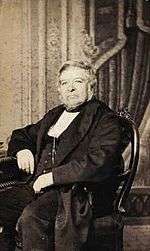Grandjean House
The Grandjean House (Danish: Grandjean s Gård) is a Late Neoclassical property consisting of two separate buildings, one at Bredgade 4 and one at Store Strandstræde 3, on each side of a central courtyard, in central Copenhagen, Denmark. . The property is separated from Kongens Nytorv by a small building that now houses Copenhagen Amber Museum. It was built in 1854 by the architect Christian Tybjerg for pastry chef Christian Bredo Grandjean. It replaced an older building, which was known as the Collin House after Hans Christian Andersen patron Jonas Collin, but this name is now associated with another building in Amaliegade. The Gtandjean House was listed on the Danish registry of protected buildings and places in 1959,
| Grandjean House | |
|---|---|
Grandjean s Gård | |
.jpg) The building on Bredgade | |

| |
| General information | |
| Architectural style | Late Neoclassical |
| Location | Copenhagen, Denmark |
| Country | Denmark |
| Completed | 1854 |
| Client | Christian Bredo Grandjean |
| Design and construction | |
| Architect | Christian Tybjerg |
History
Early history
A house built at the site in the 17th century was for a while the residence of Bernardino de Rebolledo, the Spanish ambassador to Denmark at that time.[1]
The building was in 1733 acquired by Tønnes Becker, a wealthy timber merchant and one of the City's 32 Men.[2]
The Collin family


Jonas Collin lived at the address from 1802–38. He was a prominent citizen and leading patron of the arts during the Danish Golden Age as well as a close friend and loyal supporter of Hans Christian Andersen. Allegedly, Jonas Collin decided to move when it rained through the ceiling and onto the table in the presence of Bertel Thorvaldsen. In 1839 the Collins moved to Amaliegade (No. 9).
Current building


Jonas Collin sold the property at Store Strandstræde to the pastry chef Christian Frederik Bredo Grandjean who was already operating a conditori from a pavilion in the courtyard behind the mainhouse.
Grandjean built the current house in 1854 with the assistance of the architect Christian Tyberg. Grandjean took up residence in the house and operated a restaurant and a conditori from the lower floors. It was frequented by many actors and artists, most notably Hans Christian Andersen who was a private friend of the Grandjean's.[1]
Architecture
The property consists of two individual buildings: A large, 11-bay building towards Bredgade 4 (No. 4) and a five-bay building towards Store Strandstræde. The complex was constructed with four floors towards Bredgade but only three flors towards Store Strandstræde to allow for better air circulation in the courtyard. The large, arched windows in the ground floor, a typical feature of commercial properties from the Late Neoclassical period (1830–1855), were a novelty in Denmark at the time.[3] Next to it is a narrow three-bay building over four floors on Store Strandstræde. The architect originally made a design proposal which comprised the corner on Kongens Nytorv but Grandjean failed to acquire the small Kanneworff House which now houses Copenhagen Amber Museum.[4] The former conditori contains six murals by Christian Hetsch.[5]
Today

The complex is owned by fifth generation of the Grandjean family. Restaurant Els is located at Store Strandstræde 3. It serves a seasonal cuisine and the décor includes tables that were specially manufactures for the place by Royal Copenhagen.[6] The ground floor also contains several stores, including an Yvonne Koné's flagship store.
See also
References
- "Grandjeans gård – Store Strandstræde 3". hcandersen-homepage.dk (in Danish). Retrieved 1 August 2016.
- "En af Stadens 32 Mand". -familienshistorier.wordpress.com (in Danish). Retrieved 8 February 2019.
- "dansk nyklassicisme". danskarkitektur.dk (in Danish). Retrieved 1 August 2016.
- "Store Strandstræde 3 / Bredgade 4". -indenforvoldene.dk (in Danish). Retrieved 1 August 2016.
- "StoSag:Frandjeans Gård". -Kulturstyrelsen (in Danish). Retrieved 1 August 2016.
- "Restaurant ElsGård". -AOK (in Danish). Retrieved 1 August 2016.